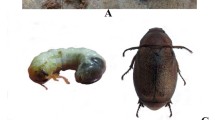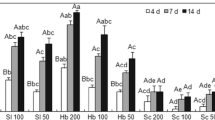Abstract
The striped flea beetle, Phyllotreta striolata (F.) (Coleoptera: Chrysomelidae), is an economically important pest on crucifer vegetables worldwide. Twenty isolates of entomopathogenic nematodes (EPNs) (Rhabditida: Steinernematidae and Heterorhabditidae) were evaluated against soil-dwelling stages of the flea beetle in the laboratory. The corrected mortalities and reproduction rates at a concentration of 36 infective juveniles (IJs) cm−2 surface area of sand against third instars of the pest greatly differed among the tested isolates, ranging from 6.7% to 100%. When tested over a range of temperatures from 15°C to 35°C, 25°C was found to be the optimal temperature for four selected nematode isolates (Steinernema carpocapsae All, Steinernema pakistanense 94-1, Heterorhabditis indica LN2 and H. indica 212-2) to infect the third instar and reproduce in the cadavers. S. pakistanense 94-1 and H. indica 212-2 showed markedly greater heat-tolerance compared to S. carpocapsae All and H. indica LN2. Corrected mortalities and reproduction rates increased as the concentration of IJs increased from 4 to 36 IJs cm−2. The LC50 values of S. carpocapsae All, S. pakistanense 94-1, H. indica LN2 and 212-2 were 17.1, 15.5, 6.5 and 5.9 IJs cm−2, respectively. The third instars larvae and pupae of P. striolata were more susceptible to the four nematode isolates than the first and second instars. Higher pathogenicity and greater heat tolerance and reproduction potential makes H. indica 212-2 the most promising candidate for the biological control of P. striolata under the field conditions of South China.



Similar content being viewed by others
References
Abbott WS (1925) A method of computing the effectiveness of an insecticide. J Econ Entomol 18:265–267
Alekseev E, Glazer I, Samish M (2006) Effect of soil texture and moisture on the activity of entomopathogenic nematodes against female Boophilus annulatus ticks. Biol Control 51:507–518
An R, Grewal PS (2007) Differences in the virulence of Heterorhabditis bacteriophora and Steinernema scarabaei to three white grub species: the relative contribution of the nematodes and their symbiotic bacteria. Biol Control 43:310–316
Ehlers R-U, Niemann I, Hollmer S, Strauch O, Jende D, Shanmugasundaram M, Mehta UK, Easwaramoorthy SK, Burnell A (2000) Mass production potential of the bacto-helminthic biocontrol complex Heterorhabditis indica––Photorhabdus luminescens. Biocontrol Sci Technol 10:607–616
Feng HT, Huang YJ, Hsu JC (2000) Insecticide susceptibility of cabbage flea beetle (Phyllotreta striolata (Fab.)) in Taiwan. Plant Prot Bull Taipei 42:123–146
Gao ZZ, Wu WJ, Cui ZX (2000) Studies on the host range of Phyllotreta striolata (F.). Ecol Sci 2:70–72
Glazer I, Gol’berg A (1989) Laboratory evaluation of steinernematid and heterorhabditid nematodes for control of the beetle Maladera matrida. Phytoparasitica 17:3–11
Grant JA, Villani MG (2003) Soil moisture effects on entomopathogenic nematodes. Environ Entomol 32:80–87
Grewal PS, Lewis EE, Gaugler R, Campbell JF (1994a) Host finding behavior as a predicator of foraging strategy in entomopathogenic nematodes. Parasitology 108:207–215
Grewal PS, Selvan S, Gaugler R (1994b) Thermal adaptation of entomopathogenic nematodes: niche breath for infection, establishment and reproduction. J Therm Biol 19:245–253
Grewal PS, Grewal SK, Malik VS, Klein MG (2002) Difference in susceptibility of introduced and native white grub species to entomopathogenic nematodes from various geographic localities. Biol Control 24:230–237
Grewal PS, Ehlers RU, Shapiro-Ilan DI (2005) Critical issues and research needs for expanding the use of nematodes in biocontrol. In: Grewal PS, Ehlers R-U, Shapiro-Ilan DI (eds) Nematodes as biocontrol agents. CABI, New York, pp 479–490
Guo CL, Qin LY, Chen HS, Liu Y, Zeng T (2006) Studies on antifeeding and contact toxic activities of crude extracts of Meliaceae against Phyllotreta striolata (Fabricius). Guangxi Sci 3:71–74
Hazir S, Stock SP, Kaya HK, Koppenhőfer AM, Keskin N (2001) Developmental temperature effects on five geographic isolates of the entomopathogenic nematode Steinernema feltiae (Nematoda: Steinernematidae). J Invertebr Pathol 77:243–250
Hou YM, Pang XF, Liang GW (2001) On the partial application of Steinernema carpocapsae strain A24 against striped flea beetle Phyllotreta striolata. Acta Phytophyl Sinica 28:151–156
Jabbour R, Barbercheck ME (2008) Soil and habitat complexity effects on movement of the entomopathogenic nematodes Steinernema carpocapsae in maize. Biol Control 47:235–243
Kakizaki M (2004) Control effect of the striped flea beetle, Phyllotreta striolata (Fabricius), by application of the entomopathogenic nematode, Steinernema carpocapsae, on a Japanese radish. Annu Rep Soc Plant Prot North Jpn 55:221–225
Knodel JJ, Olson DL (2002) Crucifer flea beetle: biology and integrated pest management in canola. http://www.ag.ndsu.edu/pubs/plantsci/pests/e1234w.htm. Accessed 29 April 2010
Koppenhöfer AM, Fuzy EM (2006) Effect of soil type on infectivity and persistence of the entomopathogenic nematodes Steinernema scarabaei, Steinernema glaseri, Heterorhabditis zealandica, and Heterorhabditis bacteriophora. J Invertebr Pathol 92:11–22
Koppenhöfer AM, Kaya HK, Taormino S (1995) Infectivity of entomopathogenic nematodes (Rhabditida: Steinernematidae) at different soil depths and moistures. J Invertebr Pathol 65:193–199
Koppenhöfer AM, Brown IM, Gaugler R, Grewal PS, Kaya HK, Klein MG (2000) Synergism of entomopathogenic nematodes and imidacloprid against white grubs: greenhouse and field evaluation. Biol Control 19:245–251
Koppenhöfer AM, Grewal PS, Fuzy EM (2006) Virulence of the entomopathogenic nematodes Heterorhabditis bacteriophora, H. zealandica, and Steinernema scarabaei against five white grub species (Coleoptera: Scarabaeidae) of economic importance in turfgrass in North America. Biol Control 38:397–404
Kung SP, Gaugler R, Kaya HK (1991) Effects of soil temperature, moisture, and relative humidity on entomopathogenic nematode persistence. J Invertebr Pathol 57:242–249
Lai RQ, You MS (2005) Anti-feeding effect of the extracts from non-preferable plants on adults of the striped flea beetle Phyllotreta striolata (F.). Plant Prot 4:37–41
Peters A, Ehlers R-U (1994) Susceptibility of leatherjackets (Tipula paludosa and T. oleracea; Tipulidae; Nematocera) to entomopathogenic nematode Steinernema feltiae. J Invertebr Pathol 63:163–171
Phan KL, Tirry L, Moens M (2005) Pathogenic potential of six isolates of entomopathogenic nematodes (Rhabditida: Steinernematidae) from Vietnam. BioControl 50:477–491
Saunders JE, Webster JM (1999) Temperature effects on Heterorhabditis megidis and Steinernema carpocapsae infectivity to Galleria mellonella. J Nematol 31:299–304
Sirjani FO, Lewis EE, Kaya HK (2009) Evaluation of entomopathogenic nematodes against the olive fruit fly, Bactrocera oleae (Diptera: Tephritidae). Biol Control 48:274–280
Smits P (1996) Post-application persistence of entomopathogenic nematodes. Biocontrol Sci Technol 6:379–387
Tansey JA, Dosdall LM, Keddie BA (2008) Phyllotreta cruciferae and Phyllotreta striolata responses to insecticidal seed treatments with different modes of action. J Appl Entomol 133:1–9
Thomas WC (1986) Predation on adult Phyllotreta stiolata (F.) flea beetles by Podisus maculiventris (Heteroptera: Pentatomidae) and Nabicula americolimbata (Hemiptera: Nabidae). Can Entomol 118:731–732
Toledo J, Williams T, Pérez C, Liedo P, Valle JF, Ibarra JE (2009) Abiotic factors affecting the infectivity of Steinernema carpocapsae (Rhabditida: Steinernematidae) on larvae of Anastrepha obliqua (Diptera: Tephritidae). Biocontrol Sci Technol 19:887–898
Trdan S, Vidrih M, Valic N, Laznik Z (2008) Impact of entomopathogenic nematodes on adults of Phyllotreta spp. (Coleoptera: Chrysomelidae) under laboratory conditions. Acta Agric Scand B Plant Soil Sci 58:169–175
Wei HY, Wang GH (1993) The control effect of a Steinernema nematode against striped flea beetle. Acta Phytophyl Sinica 20:61–64
Wei HY, Wang GH, Pang XF (1992) Infectivity of the nematode, Steinernema feltiae, to the striped flea beetle, Phyllotreta striolata. J South China Agric Univ 13:26–29
Woodring JL, Kaya HK (1988) Steinernematid and heterorhabditid nematodes: a handbook of techniques. South Co-op Ser Bull 331:1–30
Wylie HG (1979) Observation on distribution, seasonal life history and abundance of flea beetles (Coleoptera: Chrysomelidae) that infest rape crops in Manitoba. Can Entomol 111:1345–1353
Wylie HG (1984) Oviposition and survival of three nearctic euphorine braconids in crucifer-infesting flea beetle (Coleoptera: Chrysomelidae). Can Entomol 116:1–4
Xu D, Huang Z, Cen YJ, Chen Y, Freed S, Hu XG (2008) Antifeedant activities of secondary metabolites from Ajuga nipponensis against adult of striped flea beetles, Phyllotreta striolata. J Pest Sci 2:195–202
Yan X, Liu XJ, Han RC, Chen SR, De Clercq P, Moens M (2010) Osmotic induction of anhydrobiosis in entomopathogenic nematodes of the genera Heterorhabditis and Steinernema. Biol Control 53:325–330
Zhang MX, Ling B, Liang GW (2000) Investigations and analysis on the population dynamics of the striped flea beetle on crucifer vegetables. Plant Prot 27:1–3
Acknowledgments
This study was funded by the Belgian VLIR own initiatives programme ENCHIBE (Entomopathogenic nematodes for sustainable control of chive midge and flea beetle in China, VLIR reference ZEIN2007PR339), the China National Science and Technology Supporting Programme (2008BADA5B03) and the Planned Science and Technology Project of Guangdong (2009B050700033).
Author information
Authors and Affiliations
Corresponding author
Additional information
Handling Editor: Ralf Ehlers.
Rights and permissions
About this article
Cite this article
Xu, C., De Clercq, P., Moens, M. et al. Efficacy of entomopathogenic nematodes (Rhabditida: Steinernematidae and Heterorhabditidae) against the striped flea beetle, Phyllotreta striolata . BioControl 55, 789–797 (2010). https://doi.org/10.1007/s10526-010-9300-3
Received:
Accepted:
Published:
Issue Date:
DOI: https://doi.org/10.1007/s10526-010-9300-3




